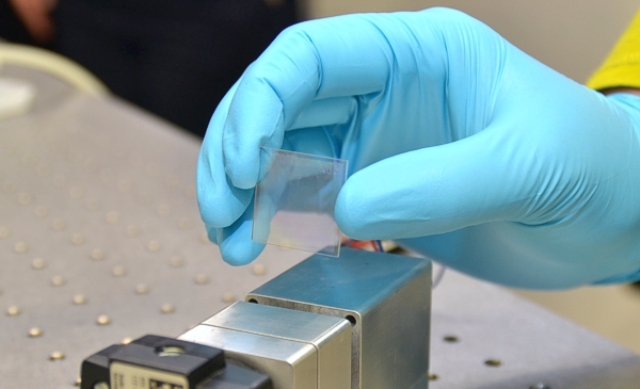Feb 11 2016
A whole lab in your hand: researchers at Kiel University have developed a chip that can recognise various proteins in a drop of blood. This could make medical diagnoses much quicker and cheaper in the future.

The chip is the size and shape of a microscope slide. Red blood cells are filtered onto it from the blood using a membrane, and the plasma is sent to the nanostructured surface of the sensor via fine capillaries. The scientists have 'stuck' various antibodies onto this surface. If the blood then flows through the chip, the proteins that match these antibodies remain behind according to the lock-and-key principle. LED light is then used to determine the concentration of these proteins. "We measure the changes in light intensity after it has passed through the sensor. We can then draw conclusions on how much of the substances is present in the blood", explained Sabrina Jahns, doctoral candidate in the Integrated Systems and Photonics working group at the Faculty of Engineering in Kiel.
The chip lab can already measure six of these so-called biomarkers, such as CD40 ligand, streptavidin and thrombin, which can indicate certain diseases. Thrombin is important for blood clotting. If the concentration of this protein in the blood is too high, a patient is probably more likely to suffer from thromboses.
Schleswig-Holstein is currently providing around 200,000 Euros in funding for the project. The goal: "We want to be able to detect 100 biomarkers on our chip", says Professor Martina Gerken, head of the project. This should be achieved in just a few months. The chip lab could be ready for the market in about five years, because measuring the amounts of the substances should become even more precise. This would mean that the long, expensive detour of blood analyses via specialist laboratories was no longer necessary. The results of measurements would be available immediately. Production costs for these disposable chips would be in the region of a few cents. The Kiel-based researchers have already applied for patent for the method, called "transmission measurement".
Original publications:
Jahns, S., Gutekunst, S.B., Selhuber-Unkel, C., Nazirizadeh, Y., Gerken, M.,“Human blood microfluidic test chip for imaging, label-free biosensor”, Microsystem Technologies 2015-12-14,10.1007/s00542-015-2746-6.
Link: http://dx.doi.org/10.1007/s00542-015-2746-6
Jahns, S., Bräu, M., Meyer, B.-O., Karrock, T, Gutekunst S. B., Blohm, L., Selhuber-Unkel, C., Buhmann, R., Nazirizadeh, Y., and Gerken, M., “Handheld imaging photonic crystal biosensor for multiplexed, label-free protein detection,” Biomed. Opt. Express, vol. 6, no. 10, p. 3724, 2015.
Link: http://dx.doi.org/10.1364/BOE.6.003724
Neustock, L. T., Jahns, S., Adam, J., and Gerken, M., “Optical Waveguides with Compound Multiperiodic Grating Nanostructures for Refractive Index Sensing”, Journal of Sensors, 2016.
Link: http://dx.doi.org/10.1155/2016/6174527